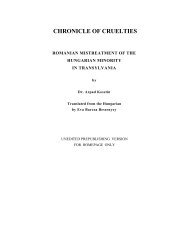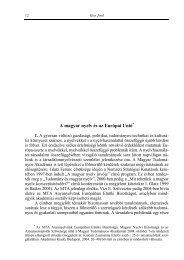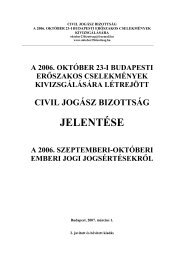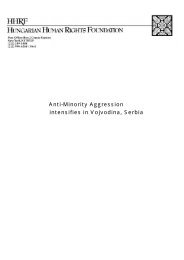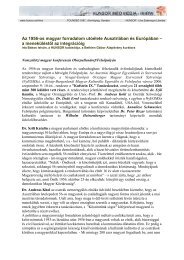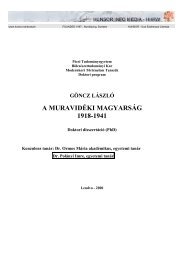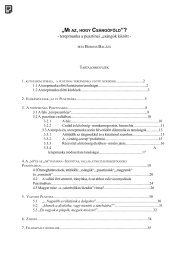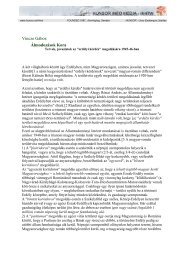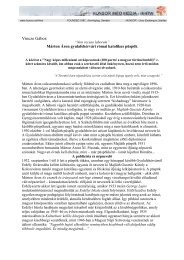1483, more than 200 thousand Serbians were transferred to Hungary. Numerous Serbians foughtagainst the Turks in the Hungarian army.The Turks occupied the central part of Hungary in 1541 and they were chased out in1686 by the United European Forces, under Prince Eugene of Savoy. It was then that a massimmigration of Serbians to Hungary started from Serbia, which was still under Ottoman rule,after the suppressed revolt against the Turks in Kosovo in 1690, the Christian nations on theBalkan peninsula were encouraged by the Austrian Emperor Leopold. Serbian patriarch ArsenijeCarnojevic from Kosovo Polje, sought asylum in Hungary with his people consisting of 36thousand families. At the time, the Serbian newcomers were not considered permanent settlers,only temporary guests.A letter written by Emperor Leopold to the patriarch testifies to this: "We will strive with all ourforce and all our ability to lead the Serbian nation that fled to our country back to their formerland and to expel the enemy from there, with our victorious arms and with the help of God."However, this did not happen. Serbia remained under Turkish rule for a long time. Acentury the Serbs who were granted asylum in Southern Hungary came up in 1790 with a claimof territorial autonomy. In 1848, after the outbreak of the Hungarian War of Independence, theyattacked the Hungarian army in the rear and proclaimed the Southern part of Hungary anindependent Voivodina.They did this in spite of Law 1848,XX. of the Hungarian Parliament which ensured completeecclesiastical and educational13self-government and free use of their native language to the Serbs, something for which aparallel could not easily be found in relation to the rights of any other nationality in Europe atthe time.After the suppression of the Hungarian war of independence by the combined forces ofAustria and Russia, Voivodina was governed directly from Vienna for a short time, but it wasreannexed to Hungary in 1860.At the outbreak of World War I, the Pan-Serbian movement, encouraged and fullysupported by Russia, openly declared that their aim was to destroy the Austro-HungarianMonarchy and to unite all the Southern Slavic nations living on its territory under Serbian rule.All over the world, Southern Slav emigrees started propaganda activities. Together with theCzech emigrees, led by Masaryk and Benes, they undertook the production of an unbridled levelof propaganda rare in modern history. In a memorandum given to the English and Frenchgovernments in May 1915, they referred to Bacska and Banat (also to Croatia and even to thesouth-western part of Hungary) as "Yugoslav national territories" under the name of Vojvodina.They tried to justify this by the false statement: "On this territory, our nation lives in a compactmass and almost without merging with other races". In order to understand the real situation, wemust turn to the data of the 1911 census referring to Bacska, when the Serb population wasrelatively the highest, the proportion of the Hungarian population was 40.5%, the Germanpopulation 29.7%, Serbs and Croats together did not reach 20%.Although theoretically the Trianon Treaty ending the war referred to the lofty Wilsonianprinciple of the "nation's rights to self-determination", what happened in reality was exactly theopposite. Two-thirds of the territory of Hungary was annexed to the neighbouring "victorious"states, along with three and a half million Hungarian inhabitants, who were not asked to whom
they wanted to belong. On the annexed territories, systematic liquidation of the Hungariannational minority that lived in a unified block started immediately. For instance, Princip, a halfofficialnewspaper in Voivodina wrote the following on September 22, 1922:"The eradication of the Hungarian race is the foremost task of the Slavs awakenedafter the war. In the course of a few decades, the tiny Hungarian oasis must be occupied with asystematic and aggressive Slav imperialist policy. Hungary must vanish from the map of Europe.The fate of minorities should not be a problem for Europe, because Europe can be consolidatedonly by the strengthening of national14majorities, thus it is her duty to assimilate minorities."These principles were also put forward in practice by the Serbs. In schools, they forcedHungarian children with various tricks to go to Serbian classes, they put an end to the training ofHungarian teachers, and they transferred a lot of Hungarian teachers to Southern Serbia, wherethere are no Hungarians. During the agricultural reforms, the Hungarian and German minoritieswere banned by decree from the right of claiming land. Hungarian minorities who remainedwithout a living were encouraged to emigrate. In the first two years, around 27 thousandHungarian emigrants left their birthplace. In place of the expelled Hungarians, the new Yugoslavstate settled more than 15 thousand families of civil servants and many thousands of"dobrovoljac" settlers among or next to the remaining Hungarians.Fortunately, the harassment of national minorities in Yugoslavia subsided after a fewyears and more peaceful years followed for the native Hungarians. As a result, Hungarianstatesmen, in agreement with the Yugoslavs, showed a readiness to forget all the injustices of thepast for the sake of appeasement. The two countries made a contract of eternal friendship in thisspirit on December 12, 1940.On March 25, 1941, Yugoslavia joined the German-Italian-Japanese Tripartite Treaty.However, on March 27, a government crisis broke out in Belgrade, and the new government wasnot willing to ratify the agreement signed with the axis powers. A few hours after receiving thenews, Hitler decided to sweep Yugoslavia out of the way of the planned campaign against theSoviet Union. He demanded the military aid of Hungary for this action. Pal Teleki, theHungarian Prime Minister, firmly opposed Hitler´s demand. He could not reconcile his honour toattack a country with whom he had signed a treaty of friendship. However, on April 2, Germantroops crossed the border of Hungary and started military operations against Yugoslavia.Hungarian officials of foreign affairs were afraid that if they continued to resist the Germandemand, Germany would occupy Hungary too. They also reasoned that Yugoslavia, as the statewith which Hungary had a treaty, had ceased to exist. Thus, they decided to reoccupy the historicHungarian territory annexed to Yugoslavia. Prime Minister Pal Teleki shot himself at the dawnof April 3, under the weight of moral responsibility.On receiving the news of Pal Teleki's suicide, Winston Churchill sent a message to theHungarian nation in the name of Britain and her allies to the effect that, in memory of the greatHungarian statesman who had refused to violate a treaty, the15
- Page 3 and 4: Library of Congress Catalogue Card
- Page 5: Mutilation of the hands or feet wit
- Page 9 and 10: individuals, then shooting them by
- Page 11 and 12: the Russians and under their protec
- Page 13 and 14: 22PEOPLE OF BEZDAN1.On a May aftern
- Page 16 and 17: 26that those people all fell victim
- Page 18 and 19: ack a 13 year-old boy to the soccer
- Page 20 and 21: Russian officers cursed and told th
- Page 22 and 23: Jani was set free for he had been a
- Page 24 and 25: There were some people who, in spit
- Page 26 and 27: March 12, 1945. The relatives of th
- Page 28 and 29: Ferenc Csapo, 33 Mihaly Miovacs, 18
- Page 30 and 31: Having heard about the advance of t
- Page 32 and 33: "On November 3, I got up at five in
- Page 34 and 35: The vicar would come every night. H
- Page 36 and 37: hand. Raising it to his mouth, he d
- Page 38 and 39: "24th October, 1944. Yesterday was
- Page 40 and 41: "I have only one chance to be sacri
- Page 42 and 43: The data, which shows that on the s
- Page 44 and 45: all the captured Serbs, as neither
- Page 46 and 47: Before and during World War II, the
- Page 48 and 49: would order fire in an instant. Wit
- Page 50 and 51: Our house looked out over the main
- Page 52 and 53: He had just arrived home after thre
- Page 54 and 55: 28. Jozsef Pasztor, 34 56. Albert G
- Page 56 and 57:
The OZNA officer, who exhumed a mas
- Page 58 and 59:
7917 year old Karoly and 8 year old
- Page 60 and 61:
82FROM SZENTFULOP TO THE GAKOVA CAM
- Page 62 and 63:
My mother died on January 4, 1946.
- Page 64 and 65:
Jozsi, the leader of our committee
- Page 66 and 67:
his own grave, then machine gunned
- Page 68 and 69:
driving a wheelbarrow on the sidewa
- Page 70 and 71:
"Now that's exactly what we needed
- Page 72 and 73:
15 Istvan Polyakovics, Zenta, 18861
- Page 74 and 75:
idge was built (from several rows o
- Page 76 and 77:
There is a common opinion among the
- Page 78 and 79:
The Catholics of the village were o
- Page 80 and 81:
and their supporters. On one occasi
- Page 82 and 83:
"My younger brother, Bandi, was tak
- Page 84 and 85:
two young instructors staying in he
- Page 86 and 87:
In Tunderes (Vilova) there was no o
- Page 88 and 89:
weeks spent starving, laying on str
- Page 90 and 91:
121PACSERAt Pacser sixteen Serbians
- Page 92 and 93:
piece of land, there are three rows
- Page 94 and 95:
"I understood that through the OZNA
- Page 96 and 97:
took the priest under their protect
- Page 98 and 99:
"We set off from Hadikliget on Octo
- Page 100 and 101:
everyone to the front! The Party us
- Page 102 and 103:
137REPORT OF LOSSESIn addition to o
- Page 104 and 105:
141Source: Zlocini okupatora u Vojv
- Page 106 and 107:
well as in words, that there had be
- Page 108 and 109:
The American military forces delive
- Page 110 and 111:
culpability or participation are th
- Page 112 and 113:
The accused did not make use of his
- Page 114 and 115:
the spirit of revenge among the Hun
- Page 116 and 117:
considered all the claims of Hungar
- Page 118 and 119:
The People's Court of Budapest just
- Page 120 and 121:
From then on all hell breaks loose.
- Page 122 and 123:
Recommended readingeRudolf Kiszlion



